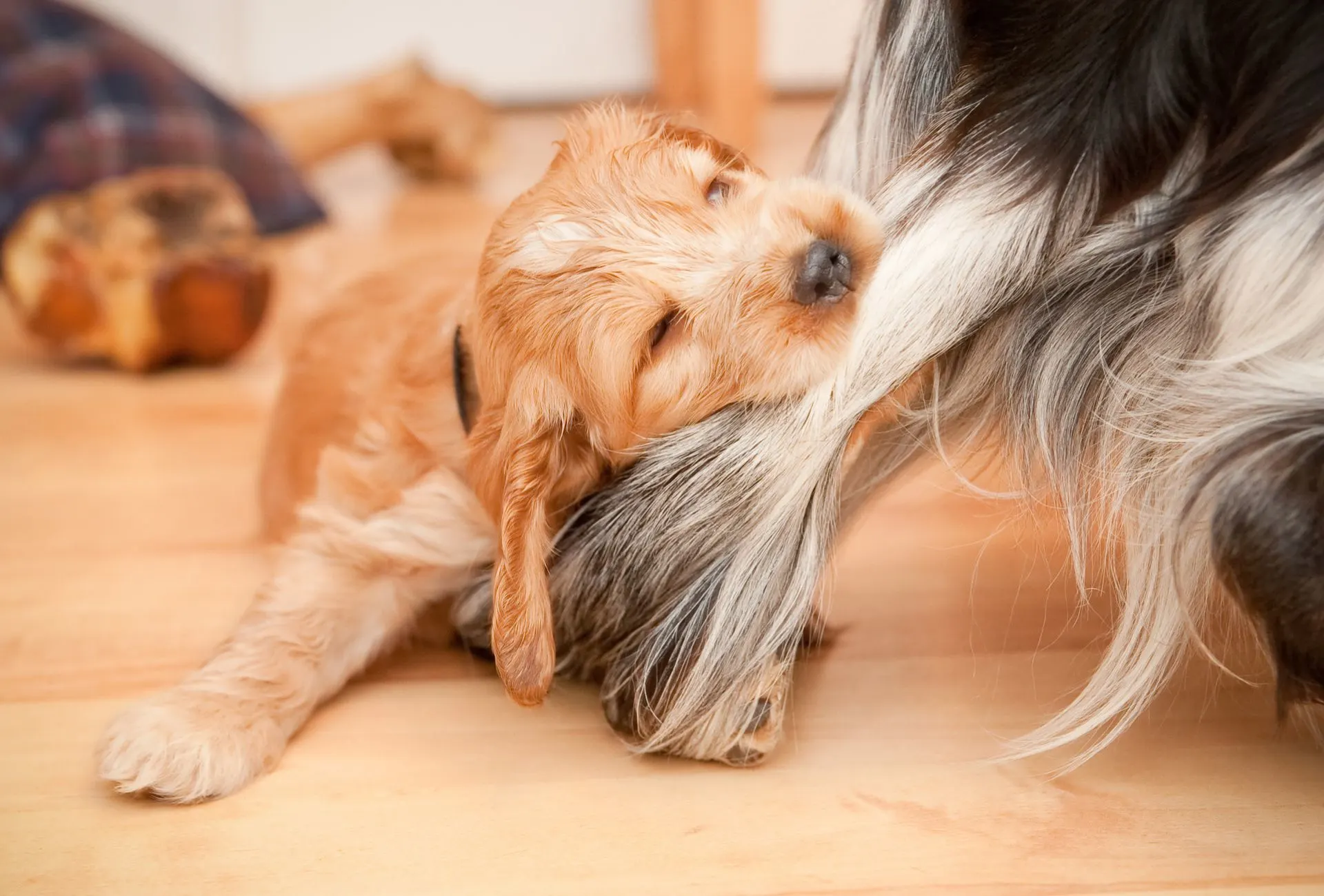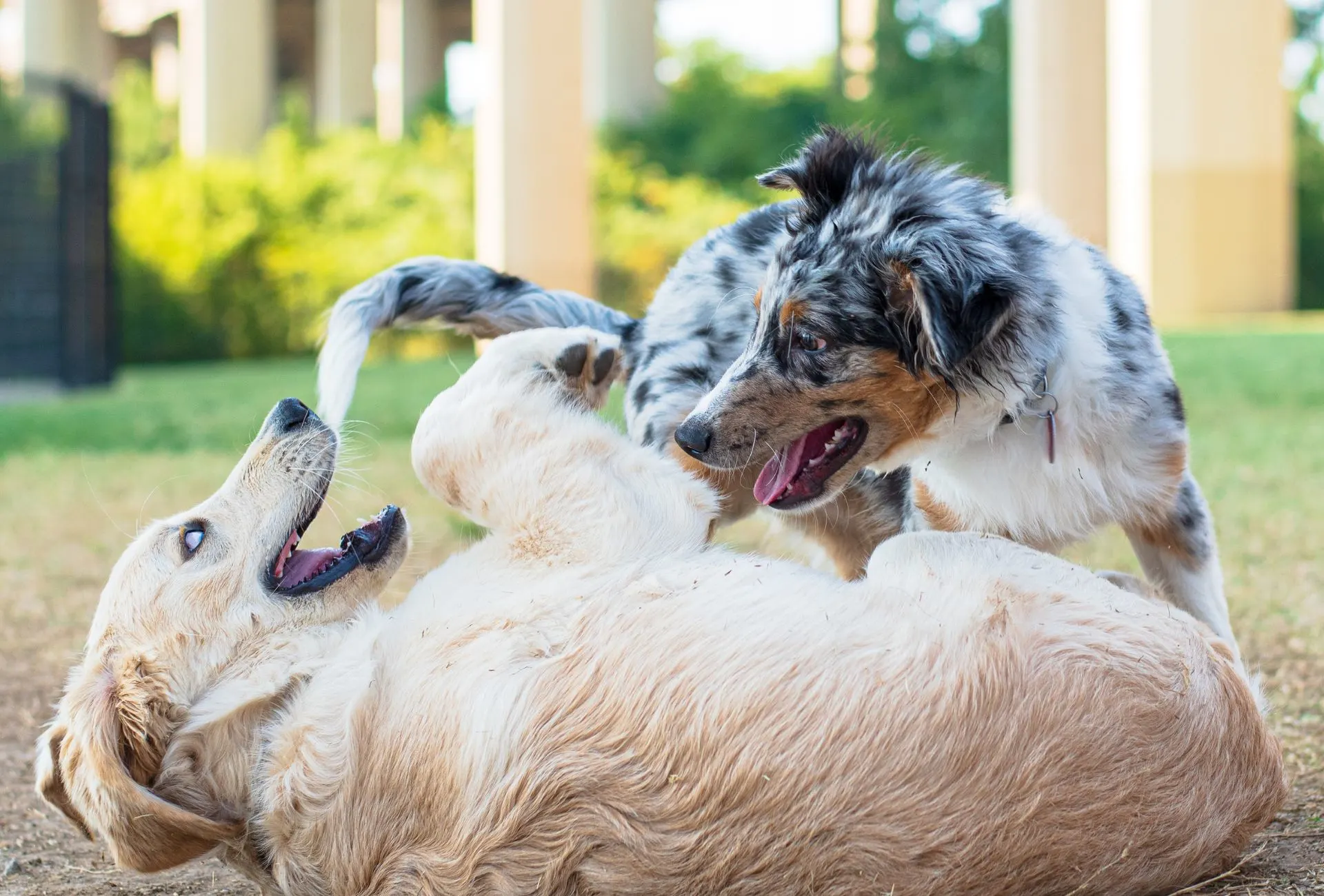Dogs can be weird and using another dog’s leg like a bone definitely falls into that category.
However, is there really more to it or is it just a fun quirk between dogs?
This largely depends on your dog and the circumstances and while most of the reasons are harmless, it can point to an underlying problem that needs to be addressed.
In short, dogs can bite each other’s legs during play, due to little playing experience, lack of bite inhibition, teething, grooming, affection, and aggression.
As you can see the reasons differ widely so let’s go into each one of them and find out why your dog is biting another dog’s legs.
8 Reasons Why Dogs Bite Each Other’s Legs
There could be many reasons for your dog’s biting but I can reassure you that most of the time, it’s simply a sign that your dog is having fun during play or showing another dog his affection.
You can determine the specific cause by observing your dog, the other dog, and their surroundings.
Just by looking at the other dog, you can immediately see whether it’s something positive or negative.
If the other dog is comfortable and enjoying the interaction, your dog probably has the best of intentions and it’s simply a normal way of canine communication.
1. Play
The most common reason for dogs biting each other’s legs is play.
Dogs can only play with their paws or their mouth and it’s normal for two dogs to mouth each other during a play session.

Some dogs tend to mouth way more than others and it can be their preferred play style.
When dogs meet each other there are usually two types, the wrestlers and the chasers.
Beyond that, there are many other play styles and some dogs just love going for those bouncy limbs (you’re lucky if that doesn’t include love munching on your limbs).
When we got a foster dog, we quickly noticed his playstyle was super focused on the legs and made a whole game out of chasing them.
My Rottweiler Amalia is usually a wrestler so she was used to lots of body contact and they managed the weirdest play scenarios and oftentimes just toppled over each other.
Play bites do not leave any marks and you should supervise play for signs of discomfort.
It can also be used to initiate a play session similar to a play bow.
2. Little Playing Experience
If your dog hasn’t experienced much play in his life, he may not know how to interact with other dogs.
Positive dog interactions are an important part of socialization and are needed to properly prepare your dog for all kinds of situations.
Different dogs have different play styles and your dog might have no idea how to handle this.
Exposure to controlled play sessions with many different dogs should curb this problem.
It’s really important that dog interactions are as positive as possible so your dog won’t walk away scared or insecure.
Your dog doesn’t have to be able to play with every dog just like humans are not always compatible with each other.
However, any behavior that really bothers or annoys other dogs should be worked on.
3. Lack of Bite Inhibition
Bite inhibition is something that dogs must learn at a young age.
As puppies, they have really sharp teeth and when they bite their littermates and especially their mother, they will receive feedback.
A bitten pup will yelp and stop playing and the dam may put a rambunctious pup in his place.
This way, they learn to adjust the strength of their jaws which eventually leads to good bite inhibition.
A dog that has been taken away from his family too early or that had little contact with dogs, in general, might have never had the chance to learn this valuable lesson.
When you take your puppy home, it’s your job to continue teaching your pup what is right and what is wrong.
Human skin or clothes cannot be bitten under any circumstances and depending on the dog, this might take a few weeks or even months.
If you are unsure how to accomplish that, read my guide on puppy biting for more tips.
This also works if you have an adult dog, it will just take more time and training.
I always recommend taking your dog to puppy socialization classes where he continues to learn such lessons during play sessions with other puppies.
4. Teething
Just like babies, puppies teeth and when those teeth want to come out it hurts and can be uncomfortable.
They start getting their baby teeth around 3 weeks old and have a full set of pearly whites at 6 to 8 weeks.
Most start losing those teeth at around 3 and a half months old and the adult molars grow at 5 to 7 months of age.
So don’t be startled when you find a small tooth on the carpet, that’s completely normal.
You should even feel blessed since most of the time, the baby teeth are simply swallowed.
During this time, puppies may become more mouthy or more destructive around the house.
This is only temporary and should pass with time.
Keep your bite inhibition training up and offer your puppy a variety of chew toys to alleviate the pain.
Some puppies prefer them soft, others harder. Many like their chew toys chilled or even frozen.
Don’t worry about leg biting too much during this time since it will most likely go away when their adult teeth have fully grown in.
5. Grooming
It’s completely normal for dogs to groom each other and it’s part of their social communication.
This usually won’t be limited to the legs and your dog might groom another dog’s ears, face, or paws.

Dogs first come into contact with grooming through their mother and it’s an important developmental stage during puppyhood.
While dogs mostly groom themselves, this attention can also be extended to their canine friends.
Licking, nibbling, and grooming release endorphins which can help combat anxiety and stress.
So it’s definitely a win-win!
6. Affection
Gently biting another dog’s legs can also be a sign of affection.
When my dog and her Saarloos Wolfdog friend cuddled up on the couch together, they loved giving each other slobbery kisses as well as some gentle nibbling.
If two dogs are really close to each other, biting the legs or other parts of the body is a way of showing that they are comfortable and trust each other.
7. Aggression
Dog aggression comes in many shapes and forms and can lead to a dog snapping at or biting another dog’s legs.
It can easily be differentiated from play by looking at the dog’s body posture.
A dog that is playing will have a relaxed body posture, eyes, and an open mouth.
The tail will be low and relaxed or wagging.
There are lots of bouncy movements and you will see the occasional play bow.
Aggression, on the other hand, comes with lots of tension.
There can be signs such as raised hackles, a stiff tail, curled lips, a forward-leaning stance, and an intense stare.
A dog that is aggressive may also be wagging his tail (although not as widely) so it’s important to always look at the full picture rather than a specific body part.
Vocalization is usually part of aggressive displays and you may hear mean growling, snarling, and barking.
Fear is most often the cause of aggressive behavior and can happen when your dog feels intimidated or scared.
There is also possessive aggression or resource guarding that oftentimes happens when one dog approaches another while they are playing with a toy.
It can also happen during meal times or around any other object that is of value to your dog.
Territorial aggression can happen when a dog enters another dog’s territory.
This usually happens at home but dogs that are really territorial might quickly claim areas outside that they have spent some time around such as picnic areas or park benches.
8. Fighting
When things go really out of hand, a dog fight can erupt.
During a dog fight, there is definitely a possibility that one dog bites another dog’s legs or other parts of his body.
Dog fights don’t have to end with wounds and most are resolved with really loud vocalization.
However, all dog fights need to be broken up before anything serious happens and the dogs should be removed from one another.
Dogs constantly communicate there are many signals that proceed to a dog fight so it’s really important to pay attention to the situation and break up the meeting when things become too heated.
If fighting happens between two of your dog in your own household, consider reading this article.
Should You Stop Leg-Biting Between Dogs?
Whether you should stop leg biting between dogs or not largely depends on the reasons.
If it only happens during play and your dog is very familiar with the other dog, there is no need to discourage it.
Unless the familiar dog is bothered by it.
However, if you meet a strange dog for the first time, it might be best not to allow excessive leg biting since this could lead to conflict.
Not every dog accepts this behavior and might even see it as intimidating.
When dogs first meet, they don’t know much about each other and while some dogs are more extroverted and open others may be intimidated by their personality and could react with fear.
There is also nothing wrong with mutual grooming between dogs, quite the contrary.
As I have mentioned above, lack of bite inhibition and socialization need to be worked on to resolve the problem.
Possible aggression is something that you should take very seriously and consider getting help from a professional trainer that has experience with aggressive dogs.
Disclaimer: This blog post does not substitute veterinary attention and does not intend to do so. I am not a veterinarian or pet nutritionist. If your dog shows any sign of illness, call your vet.